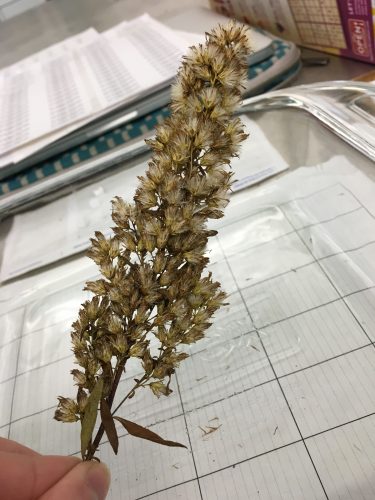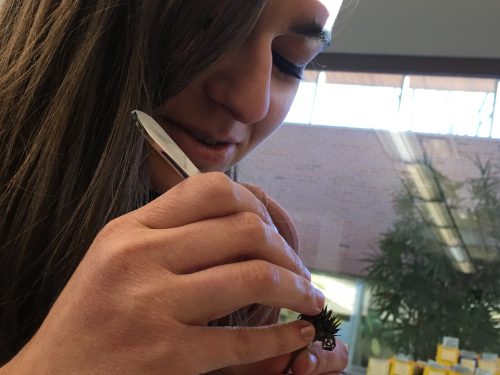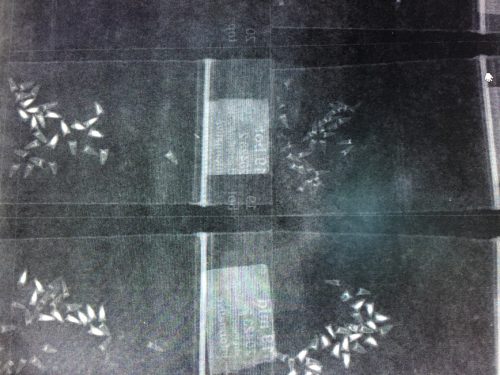Nina here! Trevor and I were hard at work today, getting our achenes ready to be X-rayed and counted. I finished randomizing achenes in preparation for X-raying them later, and started counting the achenes in each of my samples. Trevor finished cleaning his achenes, placed them all on X-ray sheets, and X-rayed all his samples. Now he has to count which of the achenes in each of his samples were full and which do not havean embryo. An image of one of his X-ray sheets is below.
|
||||
|
Trevor here and reporting that me and Nina are very “hatisfied” with our progress from the day. As we sat alongside each other, working on our various tasks, we invented a new word in the english dictionary: “hatisfied.” It translates to, roughly, being satisfied with being at or around halfway done. I am around halfway done cleaning my solidago samples and will most likely finish tomorrow. After that, I will move on to arranging my baggies on x-ray sheets and then x-raying them to discern if there is an actual embryo in the achene. How exciting!
It seems as if we are nearing the end of phase one for both of our projects and both Nina and I are so excited to see what comes next! See you soon—and remember to stay “hatisfied!” Nina here! Today, Trevor continued cleaning his Solidago heads, which have very small and delicate achenes. However, because his achenes are so small and fluffy, they tend to fly everywhere, including onto the bread that Trevor was eating! He cleaned 28 heads today, which was very impressive. Meanwhile, I finished re-checking my Echinacea heads for any stray achenes that were stubbornly clinging to the heads and proceeded to scanning the achenes for counting. While I was re-checking, I found quite a few miscellaneous bees and spiders, some of which are pictured below. Also, a picture of one of my scans below – for this site, the achenes needed to be separated according the the location that they came from on the head, so ‘top,’ ‘mid,’ ‘bot,’ and ‘other’ achenes were segregated. Next week, I hope to start randomizing my samples for X-raying and counting the scans that I took. Trevor hopes to finish counting and move on to X-raying next week as well. We also had a lab meeting today to discuss a draft of a paper on Echinacea pollination, specifically analyzing the number of pollinators over the course of the season as well as type of pollinator and quality of pollination. The paper had some interesting (and confusing!) results, so it was nice to discuss the draft with others from the lab and look at the feedback that the draft received from reviewers.
Trevor here, reporting on a day of momentous occasions; Nina and I completed step one in each of our projects! After being told, for the third time, that we look related to each other (hence the title), we decided that we had to get focused and finish cleaning—and so we did. I completed cleaning the 89 buds for the liatris species whilst Nina finished completed her 78 buds for the echinacea species; we were very excited! After taking a quick lunch break, we got back on the grind to begin phase two. Nina, being the diligent worker she is, began rechecking her echinacea buds for missed achenes. As for myself, I progressed onto the second species in my study: solidago.
Here is an image of one of the buds from the solidago species I’m working on; isn’t it beautiful?! While liatris and solidago are generally similar in biological makeup, they do possess some noticeable differences. First of all, the achenes in solidago are quite tiny (think half the size of a mosquito), which makes them extremely difficult to separate efficiently for future x-raying. Additionally, they have so many achenes that it makes it impossible to effectively pull out all the achenes from the bud. Instead, I get to do a fun shaking method where I shake off achenes into the tray. Just shaking my way to success; I guess.
Until Next Time, Hey, this is Nina! Today at the Chicago Botanic Garden, Trevor and I continued cleaning Echinacea, Liatris, and Solidago heads. We learned a new technique to clean seed heads today, which involves sorting the achenes based on the location on the head. For my Echinacea heads, I separated 30 achenes from the top of each head and 30 from the bottom of each head (not including any ray achenes present at the bottom of the head). Here’s a timelapse of me cleaning one of the heads. I got some help today when Marisol, a lovely intern from Lake Forest College, helped me clean some of my Echinacea heads. Trevor separated achenes based on location on and counted the number present on each head. From preliminary data, Trevor thinks there is a lot of variation from plant to plant, but no trend between numbers of achenes based on location on the stem. Tomorrow, I hope to finish cleaning my seed heads and move on to scanning! Hello, my name is Nina Denne and I am currently a freshman at Carleton College. I will be working as an extern at the Chicago Botanic Garden for the next 3 weeks, specifically looking at the relationship between reproductive fitness of Echinacea and the diversity of the surrounding habitat. For now, I’m mostly cleaning Echinacea heads and then I will be counting the achenes and X-raying achenes to determine whether they are viable. I’m very excited to be back at the Botanic Garden after having conducted a germination experiment with two species of Echinacea in high school. Trevor here! Today, me and Nina began our journey to clean the achenes of our respective species. I worked on my Liatris and Solidago species whilst Nina continued work on the echinacea species. A task of mental endurance, we did take a lunch break and another break to take bio photos on the green deck, which you can find on our introduction posts.
This is a picture displaying the echinacea bud (upper) and the respective achenes that Nina cleaned from the bud (lower). Nina admits that some of the buds were quite “stubborn” and she has to individually pluck each achene, which is not preferable. Nina prefers when the buds “behave themselves.”
Either way, Nina and I are extremely excited to begin our projects and continue cleaning first thing tomorrow! More updates to follow!
Howdy all you Flog Followers, I have returned from summer break and feel more ready than ever to dive back into the Extremes Project! Once all the achenes were randomized, I moved on to the next step: X-Raying all of the achenes. First, I put all of the informative achenes, in the clear plastic bags, onto a gridded sheet. On the sheet, the achenes are placed in numerical order. This keeps the x-ray process fast and easy to follow. Image 1:
Next, I took all of the sheets into the lab room with the X-ray machine and computer. Process for one scan (one scan = one sheet of paper, as seen in Image 1):
Image 2:
In this image there are four separate bags of achenes. Even within these four bags there is a large difference to the number of seeds found in each bag. Of the cluster of achenes on the bottom right, the majority of those achenes are full with seeds (the opaque white filling). However, directly above on the top right, all of the achenes are empty. I am excited to see all of the variation amongst this seed set and will be moving onto analysis in the next few weeks! Till next time folks, Nicolette McManus
Hi flog! Today Team Echinacea met at the garden for a day full of exciting meetings and orientation. I got in around 8 to start learning my way around the Plant Science Center, and then Gretel, Stuart, Lea, Kristen, and I met to recap the summer and talk about goals for the fall. We started planning our trips back to Minnesota to finish up field work and burn a few of the experimental plots. Before lunch, we got demonstrations by a few of the volunteers of the ACE protocol, including how to clean Echinacea heads, count achenes, and randomize achenes. After lunch we continued meeting to discuss project ideas and talk about our weekly schedules. We’re all pretty ambitious with our ideas and goals for the fall, but Stuart believes it’s possible. Can’t wait to get started! Tracie |
||||
|
© 2024 The Echinacea Project - All Rights Reserved - Log in Powered by WordPress & Atahualpa |
||||

 On the other hand, Nina moved on to randomizing today to prepare her samples for x-raying, which she admits was a more tedious task than she had initially anticipated. But she is very enamored with her randomization wheel that she has so much that it makes up for the meticulous task it is (see exhibit A to the left). She finished about half of her bags and reports feeling “hatisfied” with her progress. She hopes to be done by tomorrow so she can prepare het sheets for x-raying for Wednesday. She also reports that she is looking forward to counting because it is a beautiful, non thought-provoking task.
On the other hand, Nina moved on to randomizing today to prepare her samples for x-raying, which she admits was a more tedious task than she had initially anticipated. But she is very enamored with her randomization wheel that she has so much that it makes up for the meticulous task it is (see exhibit A to the left). She finished about half of her bags and reports feeling “hatisfied” with her progress. She hopes to be done by tomorrow so she can prepare het sheets for x-raying for Wednesday. She also reports that she is looking forward to counting because it is a beautiful, non thought-provoking task.


 Nina began meticulously rechecking her achenes. As you can see above, she was very focused. She actually invented a fun game where she would tally how many buds were missed by various people that assisted her in cleaning. As is stands now, Lea is in lead with 2 missed, Tracie second with 3 missed, and Nina (who did 60 of them mind you) is third with 4 missed. Max. On some, she even missed none! Marisol is in fourth with 5 missed, but who knows? She’s still counting! Updates to follow.
Nina began meticulously rechecking her achenes. As you can see above, she was very focused. She actually invented a fun game where she would tally how many buds were missed by various people that assisted her in cleaning. As is stands now, Lea is in lead with 2 missed, Tracie second with 3 missed, and Nina (who did 60 of them mind you) is third with 4 missed. Max. On some, she even missed none! Marisol is in fourth with 5 missed, but who knows? She’s still counting! Updates to follow.

 My buds are much less stubborn and the achenes easily fall off. In fact, my buds actually look quite different from the echinacea achenes, resembling a miniature version of the capitulum often emitted from dandelions, making them quite fun to work with! Pictured to the right, these are the achenes I separated into baggies for future x-raying (notice the formation!)
My buds are much less stubborn and the achenes easily fall off. In fact, my buds actually look quite different from the echinacea achenes, resembling a miniature version of the capitulum often emitted from dandelions, making them quite fun to work with! Pictured to the right, these are the achenes I separated into baggies for future x-raying (notice the formation!) Hello! My name is Trevor Hughes and I am a freshman at Carleton College in Northfield, MN. I am super fortunate to be joining Project Echinacea for an internship over my winter break; I’m super excited about it! Prior to my time at Carleton, I spent most of my time in high school working on the Conservation Ambassadors Board at Lincoln Park Zoo, planning events related to conservation. Fun fact: one of my events concerned urban prairie plant species (including echinacea!); how cool is that?! And through my time there, I grew to develop a passion for conservation, which will continue to grow in fortitude during my time at the Chicago Botanical Garden. Over the course of my internship, I will be working on cleaning, scanning, and counting achenes from the Liatris and Solidago species, hoping to discover findings comparable to echinacea, proving that conclusions made with regards to echinacea can be generalized to other prairie plant species in the future.
Hello! My name is Trevor Hughes and I am a freshman at Carleton College in Northfield, MN. I am super fortunate to be joining Project Echinacea for an internship over my winter break; I’m super excited about it! Prior to my time at Carleton, I spent most of my time in high school working on the Conservation Ambassadors Board at Lincoln Park Zoo, planning events related to conservation. Fun fact: one of my events concerned urban prairie plant species (including echinacea!); how cool is that?! And through my time there, I grew to develop a passion for conservation, which will continue to grow in fortitude during my time at the Chicago Botanical Garden. Over the course of my internship, I will be working on cleaning, scanning, and counting achenes from the Liatris and Solidago species, hoping to discover findings comparable to echinacea, proving that conclusions made with regards to echinacea can be generalized to other prairie plant species in the future.
